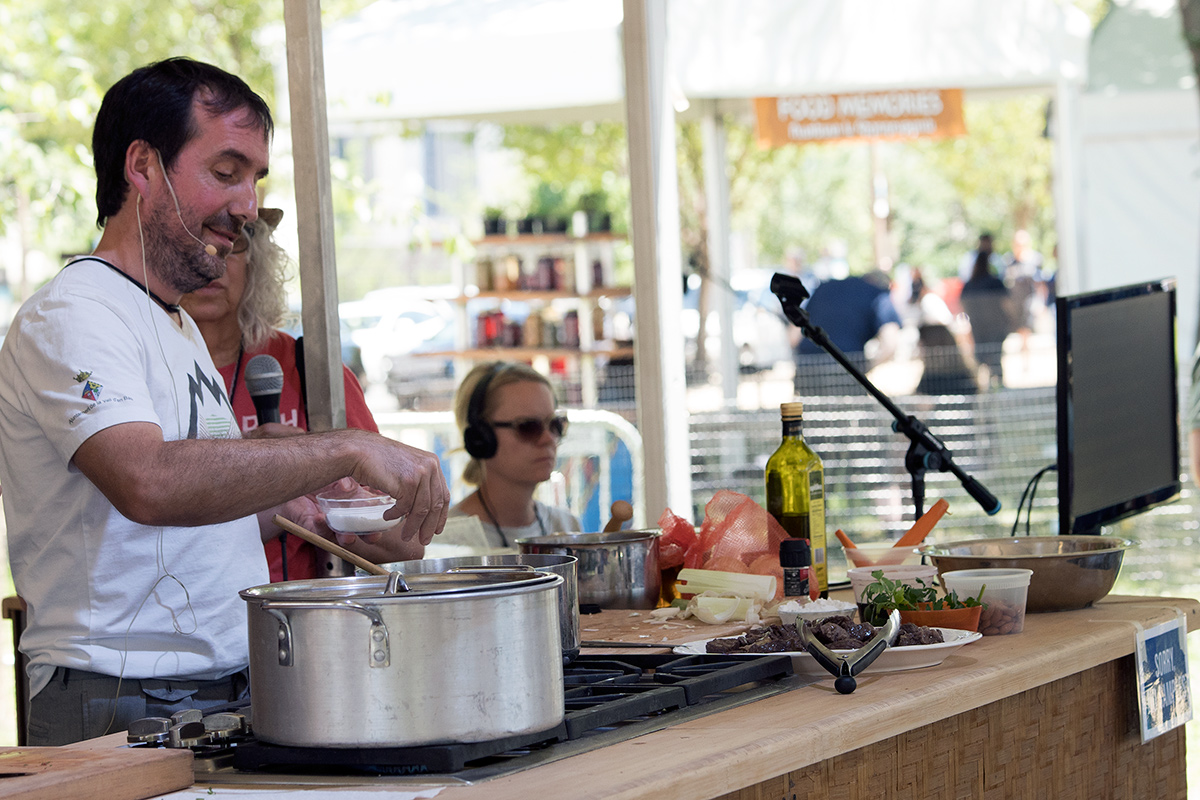Catalan Recipe: Vedella amb Bolets

Jordi Traveria cooks beef stew with mushrooms in the Hatsatoun at the 2018 Smithsonian Folklife Festival. Photo by Pruitt Allen, Ralph Rinzler Folklife Archives
Combining two hallmarks of Catalan cooking techniques, vedella amb bolets, beef stew with mushrooms, features both sofregit (tomato-based sauce used to build flavor) and picada (nut and herb paste similar to pesto). This hearty beef stew is not exactly summer fare, but a slight respite from this summer’s heat wave came on the last day of the 2018 Folklife Festival, allowing the aromas of wine-soaked beef to waft in the air and carry out on the wind.
Hunting for bolets (mushrooms) is a popular regional pastime in Catalonia, with countless websites, guidebooks, and, more recently, apps devoted to identifying where and what to pick. Mushrooms can be saved and enjoyed throughout the year by freezing or drying—though it can take up to a year to dry properly*. For this recipe, Catalan glass artist Jordi Traveria used dried chantereles and ceps (porcinis), which were easily found in a D.C. grocery store. He also recommends using dried mushrooms such as morels, dark cep, yellow foot, or St. George’s mushroom.
Traveria learned to cook from his mother and grandmother. Before his glass career, he even had a restarant that focused on serving traditional foods. He now stays involved with the food community by working with restaurants and chefs to create unique pieces.
For this straightforward stew, dried mushrooms are rehydrated in warm water prior to cooking, with the liquid reserved and used as needed. For the wine or cognac portion, Catalans also use a local wine called vi ranci—while it translates to “rancid wine,” it is actually a method of winemaking that uses deliberate oxidation. Traveria described it as an accquired taste, imparting a particular sweetness to the dish.
The cooking time of this dish is at least one and half hours, but the longer the dish is cooked, the more tender the meat with be. The dish will taste even better the next day after the flavors marry.
* Please do not attempt to hunt for mushrooms yourself for this dish if you have no prior expeience. There are many resources on the internet to find guides as well as places to buy foraged mushrooms from trained professionals.

Ingredients
Stew
2 kg beef chuck, cubed into 1 x1 cubes or to preferred size
All-purpose flour, as needed
4 onions, diced
1 head of garlic, whole and unpeeled
1 kg tomato sauce (approximately 1 16 oz can)
3 carrots, diced
1 leek, diced
3 celery stalks, diced
2 bay leaves
100 grams dried mushrooms (ceps and chantereles), rehydrated in water
Red wine or cognac, as needed
Olive oil, as needed
1 liter water, or as needed
Picada
5-7 stems parsley
100 grams roasted almonds
1 piece bread, or crackers
Salt
Pepper
Preparation
In a medium bowl, fill with warm water and rehydrate dried mushrooms. This can be done an hour or two ahead of cooking. Reserve the liquid for the stew.
Cut the meat into cubes, no more than 1-by-1-inch cubes. Place in a bowl, season with salt and pepper, and toss with enough flour to coat each piece of meat.
In a large soup pot or casserole pot on medium high heat, thickly coat the bottom of the pot in oil until it is hot.
Toss in whole, unpeeled garlic cloves into the pot. Put the meat in the pot and brown all sides. Cover the bottom with some wine or cognac and allow the alcohol to cook off and the meat to absorb the liquid. Remove the meat with tongs to a clean plate. The meat will not be cooked through, as it will be stewing for another hour at least.
Using the remaining liquid in the pot, begin the sofregit by adding the diced onions, leeks, carrots, and celery. Cook on medium heat, stirring occasionally until vegetables are tender and onions have started to caramelize. Add more olive oil and wine as needed to prevent burning.
While sofregit is cooking, remove rehydrated mushrooms from liquid and cut into smaller pieces. Once vegetables are tender, add bay leaf, tomato sauce, and cut mushrooms, and cook together for a few minutes.
Add the meat and its juices back to the pot. Add the mushroom liquid and water as need. Stir the mixture together, and turn the heat down to low/simmer. Allow stew to cook until the meat is tender, about one and half hours or longer.
Using a mortar and pestle, make the picada to finish the stew. Take the soft insides of the bread (no crust), and pound together toasted almonds, parsley, salt, and pepper. Add some liquid from the stew as needed to help the paste along. Grind into a paste and reserve to add to the stew at the very end. The stew is best eaten the next day, if there’s any left.
Kathy Phung is a foodways coordinator for the 2018 Smithsonian Folklife Festival. She also manages the demonstration kitchen at the National Museum of American History. Armed with a degree in anthropology and baking and pastry arts, she has worked in various food enterprises in the D.C. area as an oompa loompa, pastry cook, and butcher.

